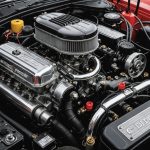Understanding Automatic Emergency Braking Systems
Automatic Emergency Braking (AEB) is an advanced safety feature designed to enhance vehicle safety by preventing collisions. The AEB functionality relies on sensors and algorithms to monitor the vehicle’s surroundings. These systems continuously scan the road ahead, measuring the distance and speed of obstacles.
The Technology Behind AEB
AEB systems utilise various sensors, such as radar and cameras, to detect potential hazards. Once a threat is identified, the system calculates the likelihood of a collision. The algorithms in place make split-second decisions to apply the brakes automatically, if necessary, to avoid or minimise impact. This rapid response is crucial, as it can act faster than human reaction times.
In parallel : Top Techniques for Assessing Vehicle Frame Integrity Post-Accident: A Comprehensive Guide
Importance in Vehicle Safety
The integration of AEB systems significantly improves the overall safety of vehicles. By reducing the probability of rear-end collisions, AEB plays a pivotal role in protecting both passengers and pedestrians. Many modern vehicles now include AEB as a standard feature, underlining its importance in the evolving landscape of vehicle safety. As technology continues to advance, AEB systems are becoming more sophisticated and efficient, offering greater peace of mind for drivers.
Common Issues with Automatic Emergency Braking Systems
Automatic Emergency Braking (AEB) systems are a marvel of modern automotive safety, but they are not without their problems. Identification of typical malfunctions often starts with recognizing symptoms like unexpected braking, failure to engage, or false positives. These issues might seem minor but can compromise the AEB performance significantly.
In parallel : Essential Tips for Safeguarding Your Vehicle”s Rollover Protection System
When facing AEB problems, it’s essential to troubleshoot effectively. Begin by checking for obstructions around sensors or cameras, as dirt or debris can lead to incorrect readings. Additionally, software glitches might require updates, easily rectifiable through manufacturer service or a knowledgeable technician.
Regular maintenance checks play a crucial role in sustaining the performance of the AEB system. Ensuring that sensors are aligned correctly and the vehicle’s software is current can prevent many common AEB problems.
Importance of regular checks cannot be overstated. They not only prolong the life of the AEB system but also ensure that it functions optimally when you need it most, providing peace of mind on every journey. Investing time in understanding these aspects can enhance the safety of your driving experience, keeping you and your passengers secure.
Maintenance Tips for Automatic Emergency Braking Systems
To achieve optimal Automatic Emergency Braking (AEB) system performance, consistent upkeep is essential. Much like any advanced vehicle technology, proper maintenance routines play a significant role in prolonging the AEB system’s life. The following guidelines offer insights into effective vehicle upkeep.
Firstly, ensure that AEB sensors remain clean and unobstructed. Dirt, mud, or ice can impede sensor functionality, causing potential malfunctions or reductions in performance. Regular cleaning will help maintain the system’s accuracy and responsiveness.
Software updates are equally crucial. These updates may enhance existing features, rectify inefficiencies, and extend the lifespan of the AEB system. Vehicle manufacturers often release updates to improve system algorithms and effectiveness. Keeping the software current ensures the system operates with the latest improvements.
Furthermore, consult your vehicle’s maintenance schedule. This often includes recommendations specifically for AEB maintenance, such as checking sensor alignment or calibration. Follow these guidelines closely to preserve the system’s integrity and avoid future issues.
These AEB maintenance tips are essential for ensuring the system works accurately when needed most, helping to enhance safety and performance on the road. Regular attention to these details supports the longevity and reliability of your vehicle’s AEB technology.
Fine-Tuning Your AEB Settings
When it comes to enhancing your automatic emergency braking (AEB) system, understanding its settings is crucial. Modern AEB systems offer various options for customization to improve their effectiveness.
Understanding AEB Settings
Navigating through the AEB settings will reveal options aimed at optimizing performance. These may include adjusting braking force, sensor calibration, and even notification preferences. Knowing these options can help in tailoring the AEB to suit your specific driving style and needs.
Adjusting Sensitivity Levels
AEB systems allow you to adjust sensitivity levels based on driving conditions. Increasing sensitivity lets the system respond quicker to obstacles, suitable for congested traffic areas. Conversely, reducing sensitivity might be beneficial on open roads to prevent unnecessary interventions.
Configuring AEB for Different Driving Environments
Customizing your AEB system for different environments is essential. In urban settings, higher sensitivity ensures quicker responses to the unpredictable nature of city traffic. In rural areas, lower sensitivity reduces false alarms caused by elements like birds or foliage. This customization not only improves safety but also enhances the driving experience by reducing system intrusiveness.
Safety Tips for Drivers Using AEB Systems
Leveraging Automatic Emergency Braking (AEB) can significantly enhance driving safety. However, it is crucial to incorporate safe driving practices alongside this technology. Here’s what you need to know to maximise the accident prevention capabilities while operating vehicles equipped with AEB.
One of the essential AEB driving tips is to always stay vigilant. Although AEB systems are designed to activate braking automatically during potential collisions, they are not infallible. Drivers must remain focused and maintain control, as AEB systems may not detect all obstacles or function optimally under certain conditions like poor weather.
Educating yourself on the limitations of AEB systems is equally important. AEB is a supportive tool, not a substitute for attentive driving. Understanding how it operates and recognising scenarios where it might underperform can help you react appropriately. For instance, while AEB works well for vehicles ahead, it might be less effective with pedestrians or other hazards.
Adhering to these principles can ensure you efficiently use the AEB technology without compromising safety. Safe driving practices complement AEB, fostering a safer driving environment.
Expert Insights and Case Studies on AEB Effectiveness
Exploring the effectiveness of AEB (Automatic Emergency Braking) unveils fascinating insights from both research and real-world scenarios. AEB case studies, conducted by esteemed safety organisations, affirm its efficacy. These studies consistently demonstrate that AEB systems significantly reduce collision rates, exemplifying their crucial role in enhancing road safety.
Expert opinions further corroborate these findings. Interviews with safety analysts and automotive engineers reveal a shared consensus on AEB’s capability to minimise crash impacts. Experts highlight that the immediate response of AEB often stops vehicles faster than human intervention, thus preventing potential accidents.
Real-world AEB case studies provide compelling evidence of successful interventions. Examples abound, where AEB has autonomously detected imminent collisions and applied brakes just in time, preventing accidents and safeguarding passengers. These instances underline the system’s reliability as a preemptive safety measure.
In summary, both the empirical evidence and expert endorsements present a compelling argument for the widespread adoption of AEB technology. It emerges as a pivotal innovation in vehicle safety, promising to mitigate accidents and enhance public safety on roads. Utilising AEB significantly contributes to a safer driving environment.
Frequently Asked Questions about Automatic Emergency Braking
Understanding Automatic Emergency Braking (AEB) can be crucial when considering a car with these features. Let’s address some common questions and concerns.
What are common concerns about AEB reliability?
A frequent worry about AEB is its reliability in various weather conditions, such as heavy rain or snow. While AEB systems are designed to perform in a wide range of environments, extreme conditions might impact sensor performance. Regular maintenance checks can help ensure sensors remain clear and functional.
Are there myths and misconceptions about AEB?
Indeed, a typical myth is that AEB systems make driving less interactive or safe. Contrary to this belief, AEB is intended to supplement drivers, not replace attention. It assists in avoiding collisions and minimizes accident severity when human reaction time may be insufficient.
What guidance is available for consumers considering AEB features?
When selecting vehicles with AEB, consider factors like sensor integration, brand track records, and user reviews. Understanding these elements helps consumers make informed decisions. Consulting the vehicle’s manual and seeking expert reviews can also clarify the specific capabilities and limitations of the AEB system.











